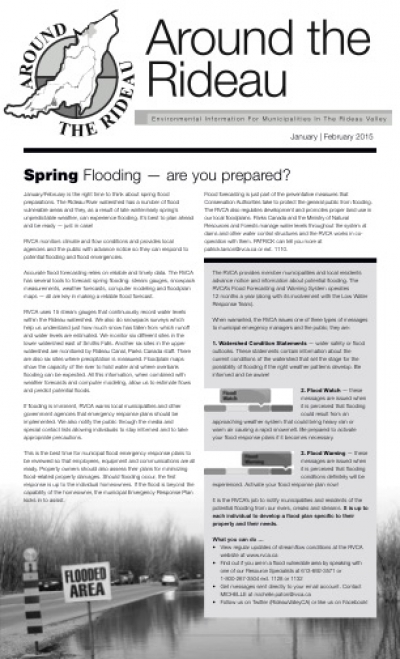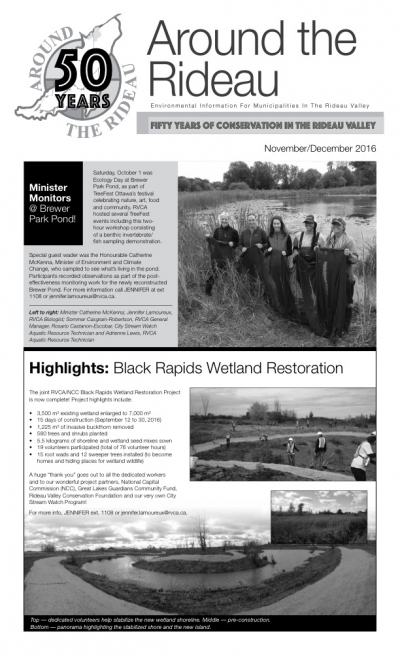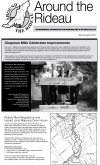
RVCA (1140)
Children categories

Department (68)
Main Office Phone Numbers : 613-692-3571 / 1-800-267-3504
Staff Directory
The City of Ottawa's Rural Clean Water Program looks to improve water quality in our local rivers, streams and creeks by reducing pollution and the volume of water running off the land. Teaming up with rural residents, the City offers financial support and technical assistance for on-the-ground projects that improve and protect water quality.
The program was developed in partnership with local farm and rural organizations, government agencies, municipalities and universities. The Conservation Authorities of Ottawa assist with program delivery.
To learn more about the program and available funding, or to submit an application form, please visit the City of Ottawa’s webpage.
1. Water Quality Protection
 Surface water runoff contains pollutants such as:
Surface water runoff contains pollutants such as:
- Fertilizers (nutrients) & pesticides
- Soil particles (sediments)
- Road salt
- Vehicle fluids (gasoline, etc.)
- Others (pet/livestock waste, septic leachate, etc.)
 These pollutants result in:
These pollutants result in:
- Algal blooms & excessive weed growth
- Loss of recreation opportunities (swimming, boating, etc.)
- Loss of fish and wildlife habitat
- Overall contaminated watersources
- Potential contamination of drinking water sources
 Naturalized, vegetated shorelines with lots of native trees and shrubs reduce these effects by acting as a buffer to:
Naturalized, vegetated shorelines with lots of native trees and shrubs reduce these effects by acting as a buffer to:
- Absorb nutrients and contaminants
- Trap sediments
- Encourage infiltration
2. Improved Wildlife Habitat
- Native vegetation along waterways provides shelter, food and safe travel corridors for wildlife.
- The berries of many shoreline shrubs provide a critical winter food source for birds and other animals.
- Fallen trees and over-hanging branches and vegetation are a natural occurrence and provide excellent habitat and refuges for fish.
- Shade provided by vegetation can significantly reduce water temperatures creating a more favourable environment for many fish species.
- Healthy fish habitat and communities contribute significantly to the economic and social interests of many Ontario communities. Angling is a $2.4 billion industry (annually) in Ontario. (Ministry of Natural Resources)
3. Erosion Protection
 Soils along the shorelines of lakes, rivers and streams are gradually weathered, displaced and deposited by various means including wind, water, ice and gravity. Although erosion is a natural process, it can be dramatically accelerated by changes in land use such as the removal of shoreline vegetation.
Soils along the shorelines of lakes, rivers and streams are gradually weathered, displaced and deposited by various means including wind, water, ice and gravity. Although erosion is a natural process, it can be dramatically accelerated by changes in land use such as the removal of shoreline vegetation.
- Without the presence of a healthy vegetated buffer, shorelines have reduced resistance against erosion, potentially resulting in a loss of habitat, soil stability and land.
- Excess sediment in the water caused by erosion can be problematic for aquatic wildlife by reducing clarity, burying fish spawning grounds, clogging gills and limiting plant growth.
- Natural, vegetated shorelines help prevent erosion because the roots of trees and shrubs trap soil in place, stabilize the bank and help to absorb wave energy.
4. Others
Requires Less Maintenance
- Naturalized shorelines require less maintenance than alternatives such as turf grass and can be left to grow on its own with minimal pruning or trimming to maintain views.
Flood Abatement
- Shoreline vegetation helps to slow down surface water runoff and encourages infiltration into the ground. This helps to reduce peak water flow and flooding during storm events and spring melts. It also helps with ground water recharge.
- Stored water is released slowly during drier periods helping to maintain water levels.
Discourages Nuisance Geese
- Shoreline trees and shrubs discourage the presence of nuisance geese by obstructing their sight lines to the water.
- Discouraging geese prevents the accumulation of goose waste which contains e. coli and nutrients harmful to water quality.
Wind Breaks
Shoreline vegetation can help protect your property from wind by acting as a windbreak. Wind breaks have many benefits including:
- erosion protection
- reduced heating costs in winter
- reduced noise and dust
Guideline for Shorelines Work in the Rideau Valley Watershed
We are working to help butternut persist on the landscape.
The Butternut Canker Disease is threatening the very survival of Butternut across the entire natural range in North America including the Butternut populations in eastern Ontario.
Butternut Recovery Program:

- informs landowners about the endangered status of Butternut and encourages them to maintain their healthy trees
- locates, assesses and maps healthy Butternut trees, to be logged in a seed-source geodatabase
- collects seeds from healthy trees and those showing signs of tolerance throughout Eastern Ontario
- grows seedlings from these seeds each fall at the Ferguson Forest Centre in Kemptville for the Landowner Butternut Planting Program, which:
- distributes 2,000 vigorous seedlings to hundreds of landowners across Eastern Ontario to replace dead and dying Butternut trees
- tracks survival and health of planted Butternuts via landowner volunteer reporting
- continually re-assesses the health of the butternut seed trees in the database and forecasts seed crops each summer
- collects leaves or buds from seed trees to DNA test for hybridization to ensure we are only collecting seeds from pure Butternut
- makes tolerant trees available for cloning to support the long-term grafting program managed by the Forest Gene Conservation Association (FGCA)
Species At Risk Compensation Program:
- makes Butternut seedlings available within MNRF Seed Zones 35 and 36 for MECP (Ministry of Environment, Conservation & Parks) compensation permits
- Seedlings are planted and maintained at several butternut groves on RVCA properties across the watershed
- These groves will be managed long-term as Butternut Seed Orchards for the recovery program.
Why Are Butternut Endangered?
Butternut trees in Eastern Ontario and across their entire natural range in North America are under attack by the Butternut Canker Disease. This is a deadly fungal disease that attacks all Butternut trees regardless of their age or size. There is no known cure for the disease but there is hope in locating trees that appear to have a natural tolerance to the disease. These rare individuals are the focus of the recovery program in Ontario for seed collection to produce vigorous seedlings for out-planting and to clone the genetic material of these trees through grafting in an effort to eventually save the species.
Butternut is classified as an endangered species under the Ontario Endangered Species Act (ESA 2007). It is illegal to harm or kill a naturally occurring Butternut tree without a Butternut Health Assessment. Seedlings planted through our program are exempt from the protection of the ESA.
Why are Butternut Important?
The Butternut (Juglans cinerea) is a native tree species that has co-existed as part of the Eastern Ontario forests for thousands of years. In Canada, it grows across southern Ontario, Quebec and New Brunswick. The presence of Butternut is important for several historical, ecological, economic and medicinal reasons:
- Butternut wood is cherished for fine furnishings, paneling, carving and turning
- Butternut bark, roots, nut oil and husks all have medicinal qualities ranging from arthritis and headache relief to lowering human cholesterol (please seek medical advice before trying)
- Butternut is an important food source for small mammals, birds and humans
- Edible nuts were used by First Nations and settlers for their high oil content and concentration of omega-3 fatty acids; the dried nuts can be stored for years
Get Involved!
There are three ways to get involved:
- If you have healthy butternut. Please contact Rose at
- If you want to plant butternut. Please contact Ian at
- If you want to volunteer to help collect seeds, let us know. Please contact Ian at
Contact:
Rose Fleguel, Butternut Recovery Technician
613-858-3678
Resources:
Lake Planning Program
NEW! Lake Protection Workbook —A Self-Assessment Tool for Shoreline Property Owners
 Learn all about the important functions of your shoreline property. Score yourself and learn about how you can make improvements that benefit your lake, river or stream.
Learn all about the important functions of your shoreline property. Score yourself and learn about how you can make improvements that benefit your lake, river or stream.
This Workbook was produced by the Lake Links Planning Committee with collaboration and review from: Cataraqui Region Conservation Authority, Friends of the Tay Watershed Association, Lake Networking Group, Lanark County Stewardship Council, Mississippi Valley Conservation Authority, Ontario Ministry of Natural Resources and Forestry, Rideau Valley Conservation Authority, and Watersheds Canada.
Printing funded by Watersheds Canada and the Daniel and Susan Gottlieb Foundation.
Digital downloads are free (8.6 MB). Printed copies are $1.50. Contact for more details.
Background
From 2005 to 2008, the Lake Management Planning Program provided information and guidance to lake groups within the Tay Valley Township and the Tay River Watershed interested in developing lake plans. The program was organized by the Friends of the Tay Watershed, Lanark County Stewardship Council, Mississippi Valley Conservation Authority, Otty Lake Association, Rideau Valley Conservation Authority, and the Tay Valley Township.
The Lake Management Planning Program provided:
- Information packages on the benefits and process of lake planning;
- Workshops aimed at sharing information about lake issues;
- Support and assistance in the development of State of the Lake Reports and Lake Plans;
- A comprehensive website offering helpful lake planning resources and templates
2009 Onward . . .
Although the funding for this very successful program has come to an end, the partners remain committed to lake planning and continued support for the development of lake plans to protect the health of local lakes and their watersheds. For more information, resources and assistance contact meaghan.mcdonald@rvca.
Helpful Links
- Lake Planning Handbook for Community Groups
- North American Lake Management Society
- A Citizen’s Guide to Lake Protection
- Guide to Lake Protection and Management
- Landowner Resource Centre
- Example Lake Plans and State of Lake Reports are available by request.
Lake Links Workshops
Since 2002, the Lake Links Workshop has been an annual opportunity for representatives of lake associations and other volunteer stewardship groups in Eastern Ontario to come together with government and non-government agencies to listen to speakers, share information, and address common lake and river issues that matter most to Eastern Ontario communities. The workshop has become an important networking opportunity for these groups and has fostered excellent partnerships, communication and collaboration with regional government and non-government organizations.
For more information on the Lake Links Workshop, visit Watersheds Canada.
More Resources
More...
Rural Clean Water Grants help to improve water quality in our local rivers, streams and creeks by reducing pollution and volume of water running off the land. Teaming up with rural residents, financial support and technical assistance are available for on-the-ground projects that improve and protect water quality.
Rural Clean Water Grants are available through one of two programs based on location:
- Ottawa Rural Clean Water Program for properties in the City of Ottawa
- Rideau Valley Rural Clean Water Program for properties outside the City of Ottawa, but in the remainder of the Rideau Valley.
Every shoreline is unique and requires different approaches to naturalization. Current and desired land use, existing conditions, soil type, availability of sunlight and moisture, and naturalization goals all play a significant role in selecting the appropriate naturalization methods. Some methods may include:
- Creating a “no-mow” zone near the shoreline and allowing vegetation to re-establish on its own.
- Active planting of native trees, shrubs, grasses, wildflowers and/or aquatic plants in the buffer area.
- Placing or allowing the accumulation of woody debris along shoreline.
- Removal or “softening” of existing hard structures like retaining walls, gabion baskets and rip rap.
- Utilizing various bioengineering methods such as coir logs, live cuttings, and brush mattresses to control or reduce erosion.

































